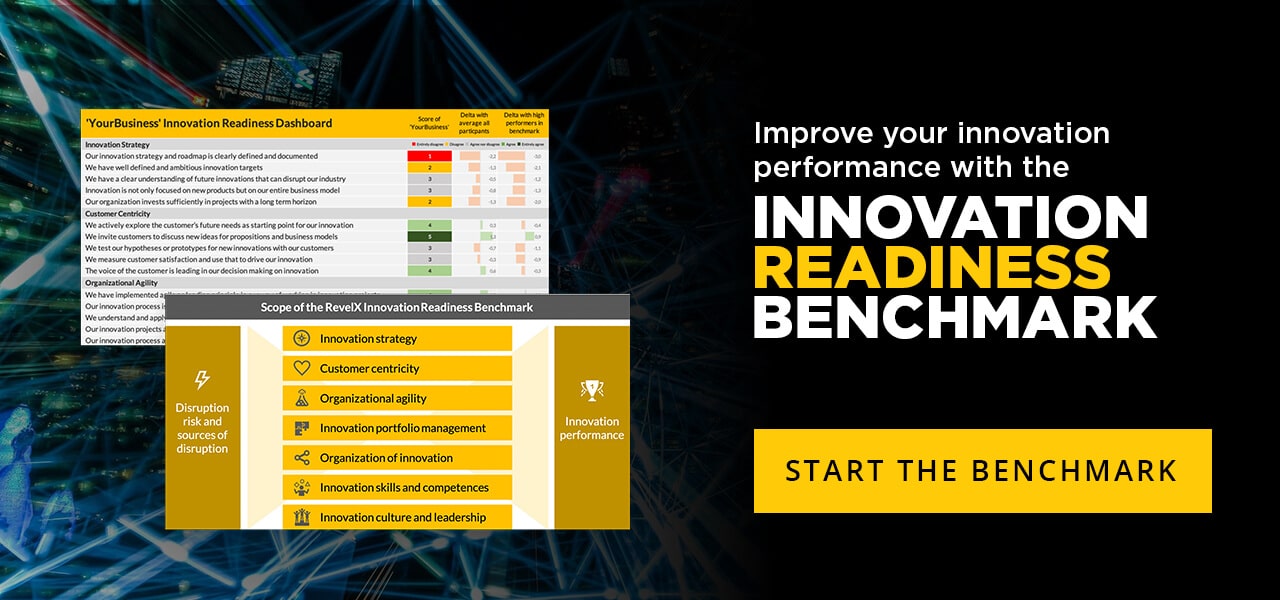This is the second blog in our series of three, taken from the recent keynote on Disruption that our colleague Matthijs Rosman held at the annual conference of the international office supply industry.
The series consists of three parts:
- Introduction to disruption and the disruption process
- Any industry can be disrupted and disruption’s leading indicators
- Strategies to counter disruption or become a disrupter yourself
Happy reading!
Any industry can be disrupted
Netflix is a famous example. But if you think about it, there are so many more. In fact, most industries are prone to disruption. The lifespan of an average company is under 20 years. As it stands, 75% of the current S&P500 companies will have disappeared by 2030.
As part of our ongoing research on innovation performance, we have found that more than 70% of respondents think their business will be disrupted.
Below you will find two more examples of industries that considered themselves in the safe zone, but appeared to susceptible to disruption after all.
The newspaper industry
The newspaper industry is heavily impacted by online news sources. When they came to the scene, they were deemed inferior by serious newsroom journalists. Newspaper customers demanded in-depth coverage of news event. Thorough analyses and opinion pieces. Over the world a drop of subscriptions in the range of 25 to 40% have become a reality. Newspaper advertizing has dropped with 25%.
In 2013, Jeff Bezos (founder and CEO of Amazon) bought the Washington Post. He turned the Post into an online newspaper and licensed its content management system.
The pharmaceutical industry
In The Netherlands, a local pharmacist started producing his own medicine for patients suffering from cystic fibrosis; an impactful long disease. He was able to produce the drug for 1/5 the price of mainstream pharmacy companies. Only to be met by the lawyers of the pharma giant.

And the list goes on…
Leading indicators your industry is about to be disrupted
Signal 1: Your assets are commoditizing
When your company assets are becoming commodities, disruptors will be around the corner. They will use your assets and build their business on top of it. Without the burden of having their own expensive assets, they will be far more profitable in no time.
Take the case of stock brokerage. This used to be a world which was complex enough to necessitate a full floor of well-paid employees. Fast forward to today and internet users can invest their money for as little as €1 per month through services as Stash and clink.
Signal 2: Your assets are under utilized
Do you have assets which are idling most of the time? In comes the disruptors to use those and make their fortune. Take AirBnB. They use the unoccupied beds and rent them out to customers. Asset heavy industries are a sitting duck to disruptors.
Signal 3: Lack of transparency
When your industry is clouded by intransparency, be on the lookout for companies who are looking to lift the vail. To outsiders, intransparant business models are suspect of hidden value. And there mostly is. Take the market for airline tickets. The pricing model was a complete black box which has been lifted by the likes of Cheaptickets and Google flights.
Signal 4: Low or no added value
When your industry includes players who add low or no value, disruptors are keen to rationalize the value chain and make their money from cutting away some fat.
Many brands have gone ‘direct to consumer’ and cut out the middleman. It is a gutsy move but done well can bring a lot of value. Many existing brands must content with competitors going direct.
There is an obvious issue here for many brands who are heavily invested in their current value chain. Either by choice or as part of their legacy. Disruptors will not have this issue.
German bicycle producer Canyon has pulled this strategy off very successfully. Being one of the first brands to sell expensive performance bikes direct to consumer through their website. At 20 to 30% below average retail for comparable bikes.
Signal 5: Platformization
When your industry is turning into a platform business either through bundling of offerings or servitization be weary of new entrants. Attention from big platforms like Amazon is also a dead giveaway. The big platforms will closely monitor your sales and then decide whether to launch their version of your products under their own brand. Take Amazon’s step into fashion.
Signal 6: Serious use pains
If customers in your market experience serious pains in using your products or services, someone will come in and simplify the job for them. Smart digital tools make complex jobs easy.
A great example is the case of Lemonade; a property and casualty insurance company. They use smart digital tools to buy insurance coverage in minutes and settle claims in no time flat.
Signal 7: Too much focus on products and features
When I discussed the process of disruption, I talked about incumbent companies being too focused on products and features for the most demanding customers.
If you find yourself in that trap, an entrant will be happy to pick up the crumbs from the business you have left behind.
Signal 8: Heightened attention from venture capitalists
Lastly, when you see venture capital entering your market, you can be sure disruption is around the corner. It is a sign money is to be made in your industry.
When I was working on a home cleaning service proposition for one of my clients, I concluded fairly quickly that unless they were willing to invest many millions on the service to scale it quickly, they had better fold. The reason being that this space of cleantech is crowded with VCs looking to go hard. Rocket Internet – the company behind Zalando – being one of them.
So, now that you realize that any industry can be disrupted, and that you are able to see it coming…. What to do about it? That’s going to be the topic of our next and last blog in this series.
Matthijs Rosman
Trusted and creative advisor. Specialist in growth acceleration and innovation. Combines analysis and creativity to develop surprising combinations. From new digital possibilities to ways to improve commercial results. Cordial towards others, sharp on details. Continuously looking for growth opportunities.
Related posts
Strategies to counter disruption or to become a disrupter yourself
We see the same things happening in the business world.…
January 7, 2021
The Great Reset: Disrupt Or Be Disrupted
We live in times of unprecedented change. In order to cope…
December 3, 2020
What Are the 5 Key Drivers for Growth?
To build a successful organization, first make sure the…
October 23, 2020




